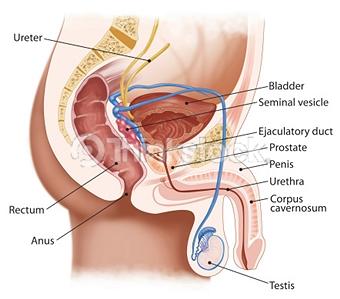Prostate Cancer Diagnosis and Testing

If prostate cancer is suspected, the care team may perform a series of tests to ensure an accurate, comprehensive prostate cancer diagnosis.
Common screening and diagnosis services may include:
- Advanced imaging technologies to detect and locate prostate tumors
- MRI-guided biopsies to increase precision and accuracy
- Pathology evaluations by experts who specialize in diagnosing prostate cancer
- Genomic testing of cancer cells to find the most effective treatments available
Screening for Prostate Cancer
Who Should Be Screened for Prostate Cancer?
The current recommendations are that men discuss routine prostate cancer screening options with their primary doctor. The discussion should take place at:
- Age 50 for men of average risk
- Age 45 for men at high risk, including African American men and those with a first-degree relative (father or brother) who was diagnosed with prostate cancer before the age of 65
- Age 40 for men at highest risk, including those with two or more first-degree relatives who had prostate cancer at an early age
Depending on your risk level, your provider may recommend two of the most common first-line screening methods: a prostate-specific antigen (PSA) test or a digital rectal examination (DRE). Depending on the results of these screenings and other risk factors, the screening may be repeated annually or once every two years.
Tests for Prostate Cancer
- Physical exam: The caregiver will examine you to evaluate your genitourinary system and your overall health.
- Prostate-specific antigen (PSA) test: This test measures PSA levels in your blood. Levels that are higher than normal may indicate prostate cancer, but can also suggest noncancerous issues such as an enlarged or inflamed prostate.
- Digital rectal exam (DRE): A doctor or nurse inserts a lubricated, gloved finger into the rectum to feel for prostate abnormalities.
- Biopsy: The surgical removal of suspicious tissues for further examination
- Transrectal ultrasound: A small probe is inserted into the rectum to take images of the prostate using high-energy sound waves. A biopsy may be taken if the images show any abnormalities. This procedure typically takes less than 10 minutes and the area may be numbed to reduce discomfort.
- Transrectal magnetic resonance imaging (MRI): This procedure images the prostate using a radio wave-emitting probe that is inserted into the rectum. The MRI machine takes a series of detailed images of the prostate and its surrounding regions. A biopsy may be taken at the same time if the images show any abnormalities.
If prostate cancer is found, additional tests are performed to determine the type and stage of the disease. These diagnostic tests may include those listed below.
- Lymph node biopsy: The removal and examination of lymph nodes in the pelvic region to determine whether cancer has spread.
- Seminal vesicle biopsy: Removal of fluid from the glands that produce semen to check if the cancer has spread.
- ProstaScint scan: Uses a small amount of radioactive material that binds to prostate cancer cells. After the material is injected, a scanner is used to detect prostate cancer spread by tracking the radioactive material in the body.
- Computed tomography (CT or CAT) scan: A series of X-ray images taken at different angles to form a computer-generated image. This can be used to determine tumor size, location and number.
- Bone scan: A procedure using a small amount of radioactive material to determine if prostate cancer has spread to the bones.
- Genomic testing: Cancerous tissue is tested to see if it exhibits certain genetic mutations, which can be used to determine better treatments.
Based on the results of these tests, the prostate cancer is then staged according to its size, the number of lymph nodes it is affecting and whether it has spread other tissue or organs.